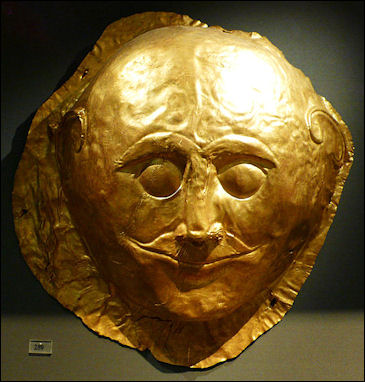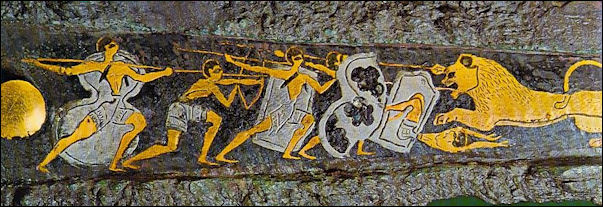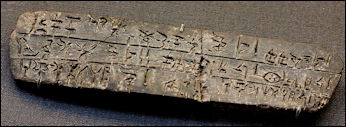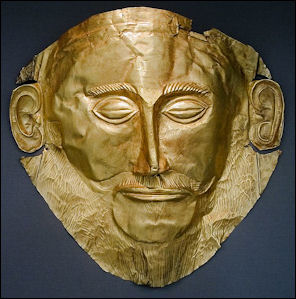MYCENAEANS

gold funerary maskThe Mycenaeans founded the first advanced Greek-speaking culture and were immortalized in Homer's Iliad . They absorbed Minoan culture but they were a warlike people like the Spartans. They thrived between 1650 and 1200 B.C., roughly a millennia before classical ancient Greece. The Mycenaeans made weapons and armor from bronze and used them to conquer other cultures. Their leaders were buried with masks of gold.
The people who became the Mycenaeans are believed to have entered the Greek mainland from the north around 2000 B.C.. After conquering the Minoans around 1400 B.C. they set up trading posts all over the Mediterranean and Aegean. Their culture was influenced greatly by the Minoans. It is believed they may have fought some battles with Egyptians and Hittites. The civilization collapsed soon after the Trojan War in 1200 B.C.
The Mycenaeans are named after the civilization's wealthiest and best-known city. Mycenae is said to have been the home of Agamemnon, the leaders of the forces against the Trojans in the Trojan wars. Many details about the Mycenaeans are found in the Iliad , some of which have been backed up with archaeological evidence.
Mycenae collapsed in 1200 B.C., perhaps as result of social unrest brought about after a series of earthquakes or famine, war or trade collapse. When the Hittite empire collapsed many great cities in Asia Minor were sacked. This have disrupted Mycenaean trade routes. Some scholars believe Mycenae was highly centralized and became overextended and collapsed under its own weight. There is no evidence of a foreign invasion or raid by tribes from the north.
Book: The Mycenaeans by Lord William Taylour
Minoans, Mycenaeans and Trojans

Mycenaean chariotThe Minoans were a model for Mycenae and then a competitor and then were eclipsed by the Mycenaeans. The two cultures lived side by side until the 15th century B.C. when Minoa became a Mycenaean colony. First it was thought that maybe Minoans and Mycenaeans were the same people and that Mycenae was a colony of Knossos. Their art, written language and religion were that similar.
The Mycenaeans were rich and powerful. They controlled the sources of precious metals and used them to earn income and dominate trading routes. They controlled the gold and silver worked by craftsmen on Minoa. Through the Minoans the Mycenaeans gained access to Egypt, a key consumer, and Cyprus, a key supplier. In the process of gaining control of key resources the Mycenaeans came head to head with the powerful Hittites in Anatolia, where Troy was located.
The Mycenaeans fought against the Trojans in the Trojan War and Odysseus, a Mycenaean, got lost on his way home from Troy. Many examples of Mycenaean weapons and armor have been unearthed seem to confirm Homer's depiction of the Mycenaeans as a warlike people. Mycenae itself was a lose confederation of small city -states ruled by warrior kings. The Mycenaeans lacked central authority and often fought among themselves.
There is still some debate on how much the Minoans influenced the Mycenaeans. The latter commonly used bulls as a symbol but people were never depicted leaping over them and some archaeologists say they looked more like cattle than sacred animals. The biggest difference is the Mycenaeans lived in fortress cities and the Minoans lived in walled cities. [Source: "History of Art" by H.W. Janson, Prentice Hall, Englewood Cliffs, N.J."
Mycenae
The Mycenaeans were ruled by a king. Under him was a “leader of the people," perhaps a military leader. There were landowners, nobles, tenant farmers, servants, slaves and people that engaged in a large number of trades and professions.
Mycenae (50 kilometers southwest of Corinth) is an ancient city, whose means "rich in gold," that was the center of the Mycenaean civilization. Founded in 1500 A.D., making a 1000 years older than Golden Age Greece, it is laid are on a small knoll next to a barren hill and features ruins of great fortess that includes a Lion's Gate constructed of huge stones piled on top of one another and a grey mound of rock which is said to bear the marks of the Cyclops, a mythological beast that is Mycenaean in origin.

Mycenaean Dagger
The massive walls of Mycenae surround palatial administrative complex, houses, sanctuaries, storerooms and royal courts with colorful frescoes and sculpted stone. Visitors to the citadel pass through the Lion Gate and reach the an ancient grave circle, where ancient Mycenaean rulers were laid to rest.
According to legend the 10-foot-thick walls that surround Mycenae and the nearby cities of Tirin and Midea were built by a tribe of men that descended from the Cyclops. When you see the size of the stones you'll understand why people believed this. The Lion Gate is composed of 10-foot-high posts with 15-foot-long lintels placed on top of them. Around the gate you can see ruts left by ancient chariots. At the center of the palace is the royal audience hall, the only room in the palace whose function has been ascertained.
Mycenae most famous native son is Agamemnon, the Greek commander who lead the attack against Troy and returned from his conquest only to be murdered by his wife Clytemnestra. It is not clear whether he was a real person or fictional character. Inside the walls of Mycenae is the royal palace where Agamemnon reportedly lived and was murdered as well as courtier houses, sanctuaries and important buildings.
The discovery of “Agamemnon's beehive tomb on a nearby hill was one of the great finds of Greek archeology and most of the treasures found inside it are now displayed in the Athens Museum. Thirteen other royal tombs and 12 tombs of normal citizens were uncovered in the same area. Several kilometers away from Mycenaea are the remains of a Mycenaean acropolis in Midea and the ruins of Heria built on an outcropping on Mt. Evvia.
Pylos

Mycenaean ruinsPylos is an ancient Mycenaean site, discovered in 1939, that is said to have been where King Nestor of the Iliad was from. It is also where the Linear B tablets were found. When these tablets were translated they revealed that the Greek language evolved out of the Mycenaean language. The small Archeological museum there houses Mycenaean pottery, lovely Hellenistic glass vases; and two small bronze figures of youths.
The Palace of Nestor was originally a sprawling two-story compound that covered a 164-by-104-foot area. Situated on a strategic ridge with views of Navarino Bay and the heart of the kingdom to the north, it was destroyed by a fire in 1200 B.C., heralding the collapse of the Mycenaean culture. The fire also baked and preserved some clay tablets with writing that led to the decipherment of Linear B.
Archeologist at the site have also found jars of herb-scented olive oil, kraters with honeyed wine and 2,853 wine cups in a single room, which has led scholars to believe that the Mycenaeans were pretty hard core partiers or they smashed these cups after each toast. In another room archeologist found the bones of 10 cattle, which have provided enough meat for 6,000 people, far more than lived around the citadel. The presence of outdoor banqueting courtyards and storerooms and pantries filled with a variety of foodstuffs and gear such as ladles, mixing bowls, wine storage jars appears to indicate that place was a huge banqueting hall that could accommodate thousands of people form all over the kingdom at one time. Status could have beeen determined by where people sat---based in the kinds of foodstuffs found in each place--- with low status people sitting n courtyards and the elite sitting with the king in a special room called the megaron.
Tirin (20 km south of Mycenaea) is a ancient city with cyclodean walls that predates Mycenae. The largest boulders in the wall weigh 13 tons, so big it is said only descendants of the Cyclops were strong enough to lift them into place. In the middle of the acropolis is a ruined palace with a royal throne room. Below it are a series of secret cisterns, or tunnels, that are among the most interesting archeological achievements of the period.
Linear B

Linear B script clay tabletThe ancient Mycenaeans had a written language in 1200 B.C., called Linear B, that was discovered on clay tablets at Mycenaean and Minoan sites. Tablets found in 1939 at Pylos by American archaeologist Carl Blegen and deciphered in 1940 by an eighteen-year-old young Englishman named Michael Ventris, who revealed his discovery in a 1952 BBC interview and also revealed that the language was a precursor of Greek and the was oldest written Indo-European language known.
These where startling revelations when one considers that no one had any idea what language the Mycenaeans spoke, that written Greek didn't reappear until 400 years later in the 5th century B.C. and that the Greek alphabet and the Mycenaean symbols looked as different from one another as Chinese and English. [Source: "The Creators" by Daniel Boorstin,"]
Blegen found 1,200 clay tablets, which had been preserved in a palace fire in 1200 B.C. He determined that Linear B there was used primarily to record palace inventories and administrative records of thing like olives, wine, chariot wheels, tripods, sheep, oxen, wheat, barely, spices, plots of land, chariots, slaves, horses and taxes to be collected. So far no references to the Trojan War or anyone mentioned in the Iliad have been found in Linear B.
3,500-Year-Old Writing Found in Mainland Greece

LinearIn the summer of 2011, a tablet with some of the oldest known examples of writing in mainland Europe, was found in the middle of an olive grove in southwest Greece, near the modern village of Iklaina. John Noble Wilford wrote in the New York Times, “The tablet seems to be a “page” from a bookkeeper's note pad. Not meant to be saved as a permanent record, it was not baked in a kiln , but ended up in a refuse dump, where a fire hardened the clay for posterity... Had it not been for some inadvertence, the tablet would almost certainly have disintegrated in the rain in a year or two and scattered with the wind as so much illiterate dust." [Source: John Noble Wilford, New York Times, April 4, 2011]
The discoverers and other specialists in Greek history said the tablet should cast light on the political structure and bureaucratic practices near the beginning of the renowned Mycenaean period, 1600 to 1100 B.C. At its height, the culture supported the splendor of palaces at Mycenae and Pylos and inspired the heroic legend of the Trojan War, immortalized in Homer's Iliad.
“This is a rare case where archaeology meets ancient texts and Greek myths," Michael B. Cosmopoulos, director of the excavations, said last week in announcing the discovery. Dr. Cosmopoulos, an archaeologist and professor of Greek studies at the University of Missouri, St. Louis, said the tablet, only 2 inches by 3 inches, was a surprise. Judging by pottery in the dump in which it was found, the tablet dates to sometime from 1490 to 1390 B.C. Scholars said they had little evidence before that clay tablets were made and used to keep state records so early in Mycenaean history.
Elsewhere, the Minoans on the island of Crete were keeping records as early as 1800 B.C. in an enigmatic script that predates the Mycenaean Linear B. The earliest known writing, also presumably for bookkeeping, evolved around 3200 B.C. in the Sumerian city of Uruk, in Mesopotamia. The first Egyptian writing appeared more or less at the same time.
The Missouri team had investigated the Iklaina site for 11 years, and in the last couple of summers examined the extensive evidence of stone walls of what may have been a palace at a district capital. Some walls are decorated with frescoes showing ladies of the court and ships with dolphins cavorting in water. There are also remains of a drainage and sewer system far ahead of its time.
Archaeologists are only beginning to consider the implications of the discovery. It suggests that political states in ancient Greece originated at least a century and a half earlier than had been documented. Iklaina may have started small and been conquered and annexed by one of the expanding powers, like Pylos, in the same region. Dr. Cosmopoulos suggested the Iklaina palace may have been a district administrative center subject to one of the main capitals: “a two-tiered government, or a sort of quasi-federal system," he called it.
3,500-Year-Old Tablet and Early Greek Bureaucratic Practices
John Noble Wilford wrote in the New York Times, “Previous excavations had yielded clay writing tablets from 1200 B.C., close to the approximate time of the supposed Trojan War, and some references to Iklaina as an administrative center associated with Pylos. Dr. Cosmopoulos said in an interview that the new findings appeared to show that some 200 years earlier this may have been the seat of an independent chiefdom that had already achieved a degree of literacy and political organization. [Source: John Noble Wilford, New York Times, April 4, 2011]

Linear tablet of Pylos
On one side, the tablet has one readable word, a verb meaning to prepare to manufacture. Along the broken edges are other characters, but not enough for scholars to make out the word or words. On the reverse side, the tablet gives a list of men's names alongside numbers. Cynthia Shelmerdine at the University of Texas, Austin, was the first to read the writing and assess its importance.
“The fact that we have a tablet like this means that this government had scribes, and scribes are a product of bureaucracy," Dr. Cosmopoulos said. “And this suggests some degree of political complexity and a growing need to keep track of commodities, property and taxes, all earlier than we once thought."
Donald C. Haggis, an archaeologist and classics professor at the University of North Carolina at Chapel Hill, said the tablet discovery was “really exciting and important because we don't know much of the dynamics of these palace sites and the early phases of state formation in Greece." Dr. Haggis, who was familiar with the research but not a member of the team, said that nearly all that had been known of the dynamics of these government centers came from excavations in the final stages of the Mycenaean period. Now the tablet, he said, “tells us this place had an administrative function at an early stage” and the architecture of the palace “reflects authority” and “looks like a place for ritual, communal dining and production of crafts."
Mycenaean Religion and Tombs

Mycenaean stirrup vaseLinear B mentions Zeus, Athena, Hera, Hermes, and Poseidon and tributes of oxen, sheep, goats pigs, wine, perfumed oil and wheat given to the gods. Deities resembling the Madonna and father-holy-ghost- child trilogy of Christianity were present in Mycenae. Some archaeologists believe the Mycenaeans performed animal sacrifices based on charred bones found at an alter. A tablet discovered with a sort of SOS on it seems to indicate that sacrifices were held after some catastrophe. The tablet was sort of a call for help.
The Mycenaeans started burying their dead in deep shaft graves around 1600 B.C. and later built huge beehive tombs and chamber tombs cut into hillsides. The deceased were buried with gold and silver masks of themselves and jewelry, toys, combs, baby bottles, tools, weapons and vessels. Often times several family members were buried in the same tomb.

Mycenaean Woman Mycenaean tombs, dated to the 11th century B.C., found on the island of Euboea, north of Athens, contained cremated remains similar to those described in Homer's Iliad . The bones were carefully wrapped in a piece of fabric and placed in a bronze urn. A huge building---about 60 feet in length---covered the site.
Mycenaean Art and Architecture
Mycenaean ceramics, painted with distinctive shiny red and black images, was crafted into storage jars and ceremonial vessels.
Architecturally the Mycenaeans were known for their fortified cities which were surrounded by walls with such large stone the some Greeks thought giants like the Cyclops were needed to build them. Mycenaean palaces were built around great central halls called megarons. Strangely one Mycenaean city---Pylos---had virtually no fortifications
Mycenae had no temples, the palaces has modest shrines. The Mycenaeans built roads graded for wagons and chariots.
The Mycenaeans built large palaces with specialized rooms for food storage, repairing chariots, making ceramics, keeping archives and writing records on stone tablets. Many of the walls were plastered and some were decorated with frescoes.
Mycenaean Economy and Trade

Mycenaen BridgeExcavations have revealed workshops with fine metal work, jewelry and carving on hippopotamus ivory. There is also evidence of bronze and perfume making. Mycenaeans paid taxes in ox hides, hogs, wool, and linen.
The Mycenaeans dominated the Argoid, an important and wealthy region in the northeast Peloponnese, and controlled trade in the Aegean Sea.
The Mycenaean's rich supply of gold is believed to have come from Egypt. Some have speculated they were hired as mercenaries by the pharaohs to get rid of unruly subject and were paid in gold.
Minoan sailors perhaps ferried the Mycenaeans back and forth and were cut in for a piece of the action. This may explain how the Minoans became so rich and their art flourished during a period of military activity around 1600 B.C.
Archaeology and Mycenae

funerary maskMycenae, was discovered by German archaeologist Heinrich Schliemann, in 1873 after his discovery of Troy in Asia Minor. Mycenae was described by Homer as being "rich in gold" and Schliemann discovered some 44 pounds of gold objects there in 1876.
Schliemann also worked in Greece tracking down sites associated with the Mycenaeans, the enemies of the Trojans. He discovered almost a dozen major Mycenaean cities and hundreds of settlements and tombs. The cities included Midea, Tiyrns "of the huge walls," "sacred"Pylos, "thirsty" Argos, and Orchemonos "rich in sheep."
Schliemann discovered some 44 pounds of gold objects at the Mycenaean sites. Most of the objects were found in a circle of six shaft graves with the remains of 19 elite Mycenaeans. Schliemann claimed he found the death mask of Agamemnon, the Mycenaean king from the Iliad .
Discovery of the "Mask of Agamemnon"

Funeral mask of AgamemnonFollowing accounts by Pausanias, a famous 2nd century traveler who described "heroes' graves...in the midst of the meeting place," Schliemann searched for the tombs of Agamemnon and Clytemnestra within the walls of the citadel in ancient Mycenae. In December 1876, Schliemann's team hit pay dirt, discovering the first of five shaft grave that would eventually yield the richest treasure from the past ever found at that point in time. The graves contained bodies "literally covered with gold and jewels." Each face, distinguishable when unearthed but quickly disintegrated by the air, was covered by a gold mask.
Schliemann believed one the masks was the "mask of Agamemnon." He also found gold diadems, gold and silver statuettes, gold sword handles, precious necklaces and bracelets, stone and gold alabaster vases, goblets of gold and silver, and hundreds of other impressive jewels.
The mask, which is now in the Archaeological Museum in Athens, has been dated to 400 years before the Trojan War. No evidence has turned up that Agamemnon was a real person. As far as we know he was only a fictional character.
Troy
see Literature
Image Sources: Wikimedia Commons, The Louvre, The British Museum
Text Sources: New York Times, Washington Post, Los Angeles Times, Times of London, Yomiuri Shimbun, The Guardian, National Geographic, The New Yorker, Time, Newsweek, Reuters, AP, Lonely Planet Guides, Compton's Encyclopedia and various books and other publications. Most of the information about Greco-Roman science, geography, medicine, time, sculpture and drama was taken from "The Discoverers" [∞] and "The Creators" [μ]" by Daniel Boorstin. Most of the information about Greek everyday life was taken from a book entitled "Greek and Roman Life" by Ian Jenkins from the British Museum [||].
No comments:
Post a Comment